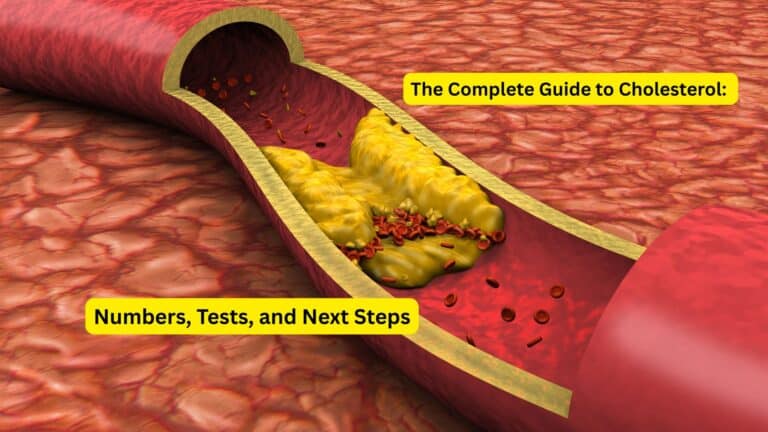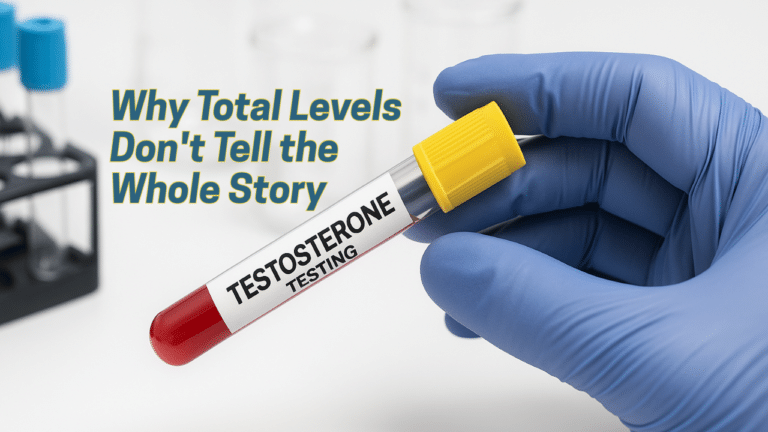The prostate gland is a small but crucial component of the male reproductive system that many men know little about until health concerns arise. Located strategically below the bladder and surrounding the urethra, this walnut-sized organ plays vital roles in both reproductive function and urinary health. Understanding your prostate’s anatomy, function, and potential health issues empowers you to make informed decisions about preventive care, recognize early warning signs, and take proactive steps toward long-term wellness through accessible testing and lifestyle modifications.
What Is the Prostate?
The prostate is fundamentally a reproductive accessory gland that serves multiple essential functions in male physiology. Understanding its basic characteristics helps men appreciate why prostate health becomes increasingly important with age.
Location & Anatomy
The prostate gland occupies a critical position in the male pelvis, weighing approximately 30 grams and measuring roughly the size of a walnut or chestnut. This small but mighty gland sits directly below the bladder, wrapping around the upper portion of the urethra while positioned in front of the rectum. Its strategic location explains why prostate issues often affect both urinary and sexual function, and why healthcare providers can examine it through a digital rectal exam.
The gland’s anatomical positioning makes it a natural regulator of urinary flow and reproductive function. As men age, changes in prostate size and texture can significantly impact quality of life, making understanding of its normal structure essential for recognizing when problems may be developing.
Function
The prostate serves as both a producer and regulator within the male reproductive system. Its primary function involves manufacturing seminal fluid, a milky, slightly alkaline substance rich in enzymes including prostate-specific antigen (PSA) and spermine. This fluid nourishes sperm cells and enhances their motility, comprising approximately 20-30% of total semen volume.
During ejaculation, the prostate’s smooth muscle contracts forcefully to propel seminal fluid into the urethra while simultaneously closing off the bladder neck to prevent urine backflow. The gland also plays a crucial metabolic role by converting testosterone into dihydrotestosterone (DHT), a more potent androgen that influences prostate growth and function throughout a man’s lifetime.
The Zones of the Prostate
Understanding the prostate’s anatomical zones helps explain why different conditions affect men in various ways and why certain areas are more prone to specific diseases. Each zone has distinct characteristics and health implications.
Transition Zone
The transition zone represents the smallest portion of the prostate, comprising approximately 10% of the gland’s total volume. This area surrounds the urethra and becomes particularly significant as men age because it’s the primary site where benign prostatic hyperplasia (BPH) develops. When cells in this zone multiply excessively, they can compress the urethra and create the urinary symptoms commonly associated with an enlarged prostate.
Central Zone
Making up about 25% of the prostate, the central zone surrounds the ejaculatory ducts where they enter the urethra. This region rarely develops cancer but can be affected by inflammatory conditions. The central zone’s proximity to the ejaculatory ducts means that problems here can directly impact fertility and sexual function.
Peripheral Zone
The peripheral zone constitutes the largest portion of the prostate at approximately 70% of total gland volume and represents the area most accessible during digital rectal examinations. This zone holds particular clinical significance because it’s where the majority of prostate cancers originate. Its location near the rectal wall allows healthcare providers to feel abnormalities during routine physical examinations, making early detection possible through regular screenings.
Why Prostate Health Matters
Prostate health significantly impacts multiple aspects of male well-being, extending far beyond reproductive function to affect daily comfort, sleep quality, and overall life satisfaction. Recognizing the importance of prostate health encourages proactive care and early intervention.
Understanding common prostate conditions helps men appreciate why preventive care matters. Benign prostatic hyperplasia affects a substantial portion of the male population, with up to 50% of men experiencing moderate to severe symptoms by age 60-69. This condition can cause frequent nighttime urination, difficulty starting urination, and a feeling of incomplete bladder emptying.
Prostate cancer presents an even more serious concern, representing the second most common cancer in American men. With approximately 280,000 new cases diagnosed annually, early detection through regular screening becomes crucial for successful treatment outcomes. Unlike many other cancers, prostate cancer often grows slowly, making it highly treatable when caught early.
Prostatitis, while less common than BPH or cancer, can cause significant discomfort through pelvic pain, difficult urination, and sexual dysfunction. This inflammatory condition particularly affects younger men and can substantially impact quality of life if left untreated.
The emotional and psychological aspects of prostate health deserve equal attention. Many men experience anxiety about prostate examinations or potential diagnosis, while others may struggle with sexual health changes related to prostate conditions. Understanding these normal concerns helps men approach prostate health with greater confidence and openness.
Prostate Testing & Screenings
Regular prostate screening represents one of the most effective approaches to maintaining long-term prostate health and catching potential problems before they become serious. Multiple testing options provide comprehensive assessment of prostate function and health status.
Digital Rectal Exam (DRE)
The digital rectal exam remains a cornerstone of prostate health assessment despite many men’s apprehension about the procedure. During this brief examination, healthcare providers can assess the prostate’s size, texture, and identify any abnormal areas that might indicate infection, enlargement, or suspicious growths. While not completely comfortable, the DRE provides valuable information that cannot be obtained through blood tests alone.
PSA Testing
Prostate-specific antigen testing measures levels of a protein produced by prostate cells, offering insights into prostate health through a simple blood draw. PSA levels naturally increase with age, but sudden elevations or rapidly rising trends may indicate infection, benign enlargement, or cancer development.
PSA testing does have limitations that men should understand. Elevated levels don’t automatically indicate cancer, as infections, recent medical procedures, or benign enlargement can also raise PSA. Conversely, some prostate cancers produce minimal PSA elevation, particularly in early stages. Healthcare providers interpret PSA results alongside other factors including age, family history, and physical examination findings.
Other Imaging and Biomarkers
Advanced testing options continue expanding for men who need more detailed prostate evaluation. Magnetic resonance imaging (MRI) can provide detailed images of prostate structure and help identify suspicious areas for targeted biopsy. Newer biomarker tests examine genetic markers in blood or urine to provide additional information about cancer risk beyond traditional PSA testing.
[COMMENT: Link to Walk-In Lab PSA Test product page here]
Walk-In Lab offers convenient, confidential PSA testing that allows men to monitor their prostate health without lengthy waiting periods or complex scheduling. This accessibility encourages regular monitoring and early detection of potential issues.
Lifestyle & Prevention
Proactive lifestyle choices can significantly impact prostate health throughout a man’s lifetime. While genetics and aging remain unchangeable factors, numerous modifiable elements offer opportunities for maintaining optimal prostate function.
Dietary modifications show promise for supporting prostate health. Research suggests reducing consumption of processed meats and high-fat dairy products while increasing intake of fruits, vegetables, and foods rich in lycopene, selenium, and omega-3 fatty acids. Tomatoes, pink grapefruit, watermelon, and green tea contain compounds that may support prostate health, though no single food provides complete protection.
Regular physical activity benefits prostate health through multiple mechanisms. Exercise helps maintain healthy body weight, improves circulation, supports immune function, and may reduce inflammation throughout the body. Men who engage in regular physical activity often experience fewer urinary symptoms and better overall prostate health compared to sedentary individuals.
Avoiding tobacco and limiting alcohol consumption support overall health while potentially reducing prostate cancer risk. Smoking increases inflammation throughout the body and may worsen urinary symptoms, while excessive alcohol consumption can irritate the urinary system and interfere with normal prostate function.
Early symptom recognition enables prompt medical attention when problems develop. Men should be aware of warning signs including difficulty starting urination, weak or interrupted urine flow, frequent urination especially at night, pain during urination or ejaculation, and blood in urine or semen. While these symptoms don’t always indicate serious problems, they warrant medical evaluation to determine appropriate treatment.
FAQs
What does the prostate do?
The prostate produces seminal fluid that nourishes and protects sperm during ejaculation. It also contracts during orgasm to expel semen and prevents urine from mixing with semen by closing off the bladder neck. Additionally, the prostate helps regulate hormone metabolism by converting testosterone to dihydrotestosterone.
Where is the prostate located?
The prostate sits directly below the bladder, surrounding the upper portion of the urethra where it exits the bladder. It’s positioned in front of the rectum, which allows healthcare providers to examine it through digital rectal examination. This location explains why prostate problems often affect both urinary and sexual function.
What are the zones of the prostate?
The prostate consists of three main zones: the transition zone (approximately 10%) where benign enlargement typically occurs, the central zone (about 25%) surrounding the ejaculatory ducts, and the peripheral zone (roughly 70%) where most prostate cancers develop. Understanding these zones helps explain different disease patterns and symptoms.
How is prostate health assessed?
Prostate health evaluation typically combines digital rectal examination, PSA blood testing, and symptom assessment. Additional tests may include urine analysis, imaging studies, or specialized biomarker tests depending on individual risk factors and symptoms. Regular screening allows early detection of potential problems.
Why is prostate health important?
Prostate conditions significantly impact urinary function, sexual health, and overall quality of life. Early detection and treatment of problems like BPH, prostatitis, or cancer can prevent serious complications and maintain normal function. Understanding prostate health empowers men to make informed decisions about preventive care and treatment options.
Conclusion
Understanding your prostate represents a fundamental aspect of men’s health that extends far beyond simple anatomy lessons. This small but vital gland influences daily comfort, sexual function, and long-term wellness in ways that become increasingly apparent with age. Knowledge about prostate structure, function, and common health issues empowers men to recognize symptoms early, make informed lifestyle choices, and engage meaningfully with healthcare providers about screening and treatment options.
Proactive prostate health monitoring through regular screenings, PSA testing, and lifestyle modifications offers the best opportunity for maintaining optimal function throughout life. The accessibility of confidential testing through services like Walk-In Lab removes common barriers to preventive care, enabling men to take control of their health journey without unnecessary delays or complications.
[COMMENT: Link back to pillar “The Complete Guide to Prostate Health” here]
Remember that prostate health concerns affect millions of men, and seeking information, testing, or treatment demonstrates wisdom rather than weakness. Early detection and intervention consistently provide better outcomes than waiting for symptoms to worsen, making regular monitoring an essential component of comprehensive men’s health care.
Medical Disclaimer: This content is for informational purposes only and does not substitute professional medical advice, diagnosis, or treatment. Always consult qualified healthcare providers for medical concerns and before making health-related decisions.






